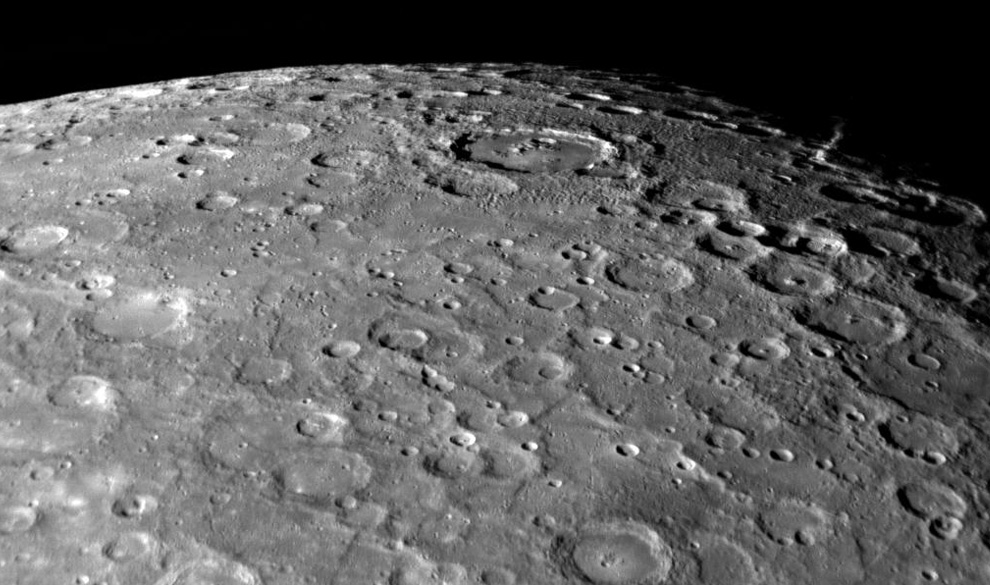In billions of years, the Mercury is coated by layers of carbon dust dumped by the passing comets. The nearest planet to the sun, Mercury is also the dirtiest of all the planets in the universe. According to a study, the surface of the planet is continuously attacked by carbon by the passing comets. Mercury’s surface has become even darker than that of moon. This is the reason why Mercury reflects lesser light than the moon.
Mercury and Moon both are roughly of the same size and as neither of them possess their own atmosphere so they are constantly attacked by space dust. Many space bodies are dark coloured due to the presence of iron particles on their surface but Mercury’s case is a bit different. According to scientist’s observations, the surface of mercury has even less than 2% of iron.
The darker surface of Mercury has remained as a mystery since a long time. It is believed that the presence of iron particles are responsible for lower reflection of light. However, according to the observation on the Moon and other asteroids, the content of iron at Mercury’s surface was not sufficient enough to be the reason behind darkening of its surface. Hence the scientists speculated that there is some mystery darkening agent that contributes to the darkening surface of mercury.
Mercury being closest to the sun, is exposed to higher frequency of comet bombardment as compared to moon. And, comets are rich carbon source. Hence, carbon is released on Mercury by the passing comets. The micrometeorites, dropped by the passing comet allows the falling particles to be retained thereby causing a carbon build up in billions of years.
Comets are nothing but the icy rocks that are left after formation of solar system in the universe and they dissolve on getting closer to the sun. As estimated by the study, the carbon micrometeorites per unit surface area dropped on Mercury are almost 50 times as compared to the moon.
However, it is impossible for a full-size comet to deposit large amount of carbon on Mercury’s surface in order to paint it dark. If a large comet collided with the planet then majority of the impact materials would go into the space. But the dust released by passing comets is a different story. And, the density of comet’s dust increases with increasing proximity to sun.
In an effort to test the theory, the scientists shot from their canon few pieces of sugar coated basalt that looks like lunar basaltic rocks, so as to observe the behaviour of the produced elements due to the collisions. During the test, the sugar melted to produce thin coating of carbon when it came in contact with moon-like rocks and thereby considerably darkened the surface moon like rocks thus reducing the reflection of light by it. Finally, the mystery of darkened Mercury has been solved by the scientists.
Mercury and Moon both are roughly of the same size and as neither of them possess their own atmosphere so they are constantly attacked by space dust. Many space bodies are dark coloured due to the presence of iron particles on their surface but Mercury’s case is a bit different. According to scientist’s observations, the surface of mercury has even less than 2% of iron.
The darker surface of Mercury has remained as a mystery since a long time. It is believed that the presence of iron particles are responsible for lower reflection of light. However, according to the observation on the Moon and other asteroids, the content of iron at Mercury’s surface was not sufficient enough to be the reason behind darkening of its surface. Hence the scientists speculated that there is some mystery darkening agent that contributes to the darkening surface of mercury.
Mercury being closest to the sun, is exposed to higher frequency of comet bombardment as compared to moon. And, comets are rich carbon source. Hence, carbon is released on Mercury by the passing comets. The micrometeorites, dropped by the passing comet allows the falling particles to be retained thereby causing a carbon build up in billions of years.
Comets are nothing but the icy rocks that are left after formation of solar system in the universe and they dissolve on getting closer to the sun. As estimated by the study, the carbon micrometeorites per unit surface area dropped on Mercury are almost 50 times as compared to the moon.
However, it is impossible for a full-size comet to deposit large amount of carbon on Mercury’s surface in order to paint it dark. If a large comet collided with the planet then majority of the impact materials would go into the space. But the dust released by passing comets is a different story. And, the density of comet’s dust increases with increasing proximity to sun.
In an effort to test the theory, the scientists shot from their canon few pieces of sugar coated basalt that looks like lunar basaltic rocks, so as to observe the behaviour of the produced elements due to the collisions. During the test, the sugar melted to produce thin coating of carbon when it came in contact with moon-like rocks and thereby considerably darkened the surface moon like rocks thus reducing the reflection of light by it. Finally, the mystery of darkened Mercury has been solved by the scientists.





